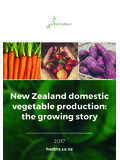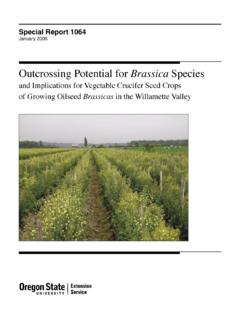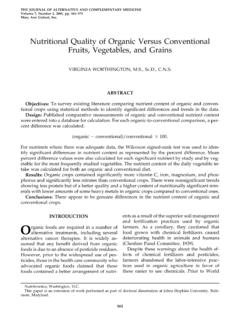Transcription of 9 Most Common Mistakes Growing Food In Cairns …
1 9 most Common MistakesGrowing food In Cairns (And The Wet Tropics) Copyright 2011 Andrew Cavanagh all rights reservedPermission is given to reproduce and sell or give away this report in its completeUNALTERED state including links and all other informationThe following are the most Common Mistakes westerners make when they decide to grow food in their home gardens in # 1: Poor Choice Of PlantsWhen most westerners think of vegetables they think potatoes, corn, onions, beetroot and 's the bad vegetables can be incredibly difficult to grow in the wet during the wet good news is there are a variety of vegetables that grow with very little maintenance here in during the wet most are you can get a crop from them for a year.
2 Often several years before you have to think about fact some tropical vegetables are so easy to grow that once they're up and running it is literally easier to go get them from your garden than to buy them from a store or you come from the background of traditional European farming where plants require such a huge effort to plant and maintain it's fantastically liberating to have a garden that grows largely without your is a list of plants that grow well here in the wet tropics in a home vegetable garden including short notes on each. For more information just make a search for each plant on Google:For more free resources and videos go to: Sweet potato. This will grow from cuttings or you can get a sweet potato and put it in a low tray of water and cuttings will grow from that.
3 Plant a few different varieties. The leaves and tubers are edible and tubers are easier to harvest if the plant is grown on a Snake beans. Grown from seed. Eat the green beans. It's a fast crop where you can have beans to eat as soon as 7 weeks after planting the seed. Snake beans are an annual crop (although in the wet tropics you can plant them all year round). You have to replant if you want more beans unlike the other plants in this list. There are both dwarf varieties and climbing varieties of snake beans. You may plant either or Sweet leaf. A small light shrub that is often trimmed to waist high. Eat the leaves and the leaf and shoot tips (which taste like peas). Can be grown from seed (it will self seed prolifically) or from hardwood cuttings.
4 It will grow in partial shade or full Kang kong (water spinach). A perennial that will grow on land or in water. Grows well near the bottom of a banana circle. The leaves, shoots and flowers are edible (just like sweet potato). Also grows from Ceylon spinach. A perennial climbing or spreading vine. Grows from seed and will self seed. Likes to grow up a trellis or tree (for example a moringa tree or pigeon pea).- Basil. Locally adapted asian varieties will usually grow like a weed (which is what you want). The plant will grow from cuttings (you can usually buy them at local buy basil from vendors).- Brazilian spinach (sissoo spinach). Attractive low Growing plant. Grows from cuttings. Will grow in partial shade to full Aibika.
5 A small shrub with large edible leaves. Originally a swamp plant so it can take being planted lower (in a dish, near the bottom of a swale or banana circle) but it will also grow happily on a mound or flat ground. Grown from hardwood Cherry tomato. Find a variety that is Growing successfully locally. Once you get a vine that is really Growing this can give you an enormous quantity of Pigeon pea. A very small nitrogen fixing shrub. Edible as a green bean and as hard seed (which can also be fed to chickens). Young leaves are edible and you can cut the plant regularly for mulch and use it as a living trellis for your cherry tomatoes and ceylon more free resources and videos go to: Moringa oleifera.
6 Very fast Growing tree which provides a very light shade. Leaves are edible and high in protein. Many other uses including cutting the tree back to use for mulch (leaves are high in nitrogen). Grows back quickly after Banana. Grows from suckers (a young miniature banana plant). Cutting off dead and dying leaves from banana plants helps to avoid many pests and Paw paw. Grows from seeds. Can bear fruit within a year of planting. Green paw paw can also be eaten as a vegetable in various ways (works well grated in salads). Fruit and seeds can also make good chicken important of all is to be observant and open you notice someone in your area successfully Growing a food plant ask them what it is and what they're may find varieties far more suited to your local area and your particular garden and area of your be open to using other edibles, herbs, ornamentals, flowers and other plants as part of your can provide valuable mulch, beauty and they can confuse pests helping your edible plants to survive and list above is quite tiny (intentionally designed to increase your chances of success starting out)
7 And our knowledge of edible gardening in the tropics is quite sparse in the western cultures have been doing this for thousands of years so we have a lot to learn and many resources and plants that we either don't know about or we've time you should be aiming to grow hundreds of different varieties of food plants in your more free resources and videos go to: # 2: Searching For Good Soil Or Blaming Bad SoilIn the tropics there is good soil. You'll find it under a half a meter layer of mulch in the rainforest (which is a pretty good model if you're looking for an example to copy from).But soil in most backyards is terrible. In many cases the topsoil has been ripped off the surface and sold by to that years of torrential rain and harsh sun and you get an idea of how little life is left in most backyard many tropical back yards where the soil is left unprotected you'll see one of the or some back yards you'll see most of the water and nutrients in the tropics is held in the plants and dead organic matter not in the 's not suggesting for a second that soil and the life in soil is not is critically when you're starting out you need to focus on creating good soil by using heavy mulch.
8 Manure and urine from animals like chickens and green manure by using leaves and branches of nitrogen fixing trees and soil creation is an ongoing process and something you will get more sophisticated at over time. Mistake # 3: Digging Or Plowing Soil And Leaving It BareIn the wet tropics the sun is too harsh and the rain is too heavy for the soil to be left exposed to the most organic matter breaks down fast (it will rot or compost very quickly).We can use this to our advantage by putting heavy mulch whenever we plant. Often you can avoid digging altogether by using a layer of cardboard or newspapers and heavy mulch on top when you more free resources and videos go to: mulch also stops plants from drying out when it's not raining which means less watering and less stress on underestimate how much mulch your garden will knee high (a good start in the wet tropics) can break down in a few short months during the wet speaking the more mulch you use on your garden the better and to reduce external inputs grow mulch in your own garden by using plants that you can cut for high quality mulch (like pigeon pea and moringa), by cutting back vines like sweet potato for mulch and by observing which ornamental plants and other plants you can use for mulch (being observant and resourceful is a huge key to being a great food gardener).
9 Neighbours may also be happy to give you cuttings from their gardens. As a basic guideline in the wet tropics you want to use a LOT of mulch in your edible food garden and have most of the soil covered by living mulch as well (plants like sweet potato, kang kong, snake beans, brazillian spinach etc etc.)Don't leave the ground fantastic starting strategy is to create a banana circle that acts as a compost pile and generates huge quantities of mulch (more on this later).Mistake # 4: Starting Too Big Or Spreading Your Effort Too ThinIt takes a LOT of mulch and a lot of plants to plant even a small area in the wet tropics so that it will grow vigorously and won't be overcome by weeds and beginners starting out will plant a corn patch in one area surrounded by the lawn grass that was Growing originally in the they might plant a climber next to a surrounded by grass and perhaps a few herbs in another then a paw paw tree near the side fence and a banana tree near the back all surrounded by lawn nothing grows well.
10 Nothing more free resources and videos go to: simply don't have the time and resources to plant this way and mulch, fertilize, water and maintain plants spread around like you concentrate all your efforts and resources in one small area when you're starting example in a banana circle 2-3 meters can mulch, fertilize and plant that small area using every resource at your can plant shrubs and trees that fix nitrogen and have leaves and branches high in nitrogen (like pigeon pea and moringa) and other plants that generate large quantities of mulch (like sweet potato and banana plants).The spreading plants (like sweet potato) will act as a weed barrier from from that concentration of your resources your garden will be easy to spread out into a larger area without requiring substantial external 'll have cuttings, seed and mulch you can 'll also have time to observe the rest of the space you want to garden and create a design that's likely to be more effective or get some expert advice on how to do 'll also have a far better idea of which plants grow vigorously, how they grow, what they like and dislike, how much you like them.





